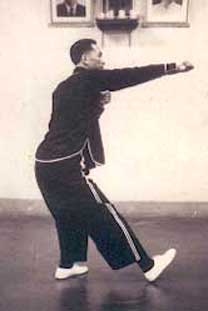Praying mantis
A very popular style and widely spread throughout the world. It was founded around 1640 by Wang Lang. Born in the Shandong province, Wang Lang already had great skills in fencing and had been fighting against oppression during the Ming dynasty. For this reason Wang Lang sought refuge in a monastery to protect himself.

The legend of the origin of the praying mantis style started when Wang Lang lost in combat to a brother monk. Dazed and confused with the defeat, Wang Lang desperately meditated and searched for a solution that would improve his combat techniques. During one of these meditative moments, Wang Lang was distracted by the fight between a praying mantis and a cicada. The much smaller and fragile praying mantis easily defeated the cicada in only a few minutes. Wang Lang captured the praying mantis and began to observe its movements, repeating them, step by step, and adapting them for combat, thus creating an effective style in Chinese martial art.
As the years went by, the legacy left by Wang Lang was improved and developed by several well-known masters, which gave rise to the creation of various Praying Mantis styles: Qi Xing (Seven Stars), Mei Hua (Plum Flower), Banguang (Shinny Board), Liuhe (Six Harmonies), Taiji (Ultimate), MiMen (Secret Door/gate), Babu (Eight Steps), Changquan (Long Fist), Tong Bei (Back Connected), Hualin and other less known styles.
The best known name connected to the Praying Mantis is that of Grand Master Wang Han Xun (Wong Hon Fan), who taught the style for many years at the Hong Kong Martial Arts Association and trained many teachers.
Qi Xing Tang Lang Quan has about thirty freehand positions and six weapon forms. Its techniques are composed of quick, short and precise movements. The attacker penetrates the opponent's guard using punches, the elbows and short kicks that almost always ends in flooring the opponent.
 The legend of the origin of the praying mantis style started when Wang Lang lost in combat to a brother monk. Dazed and confused with the defeat, Wang Lang desperately meditated and searched for a solution that would improve his combat techniques. During one of these meditative moments, Wang Lang was distracted by the fight between a praying mantis and a cicada. The much smaller and fragile praying mantis easily defeated the cicada in only a few minutes. Wang Lang captured the praying mantis and began to observe its movements, repeating them, step by step, and adapting them for combat, thus creating an effective style in Chinese martial art.
The legend of the origin of the praying mantis style started when Wang Lang lost in combat to a brother monk. Dazed and confused with the defeat, Wang Lang desperately meditated and searched for a solution that would improve his combat techniques. During one of these meditative moments, Wang Lang was distracted by the fight between a praying mantis and a cicada. The much smaller and fragile praying mantis easily defeated the cicada in only a few minutes. Wang Lang captured the praying mantis and began to observe its movements, repeating them, step by step, and adapting them for combat, thus creating an effective style in Chinese martial art.